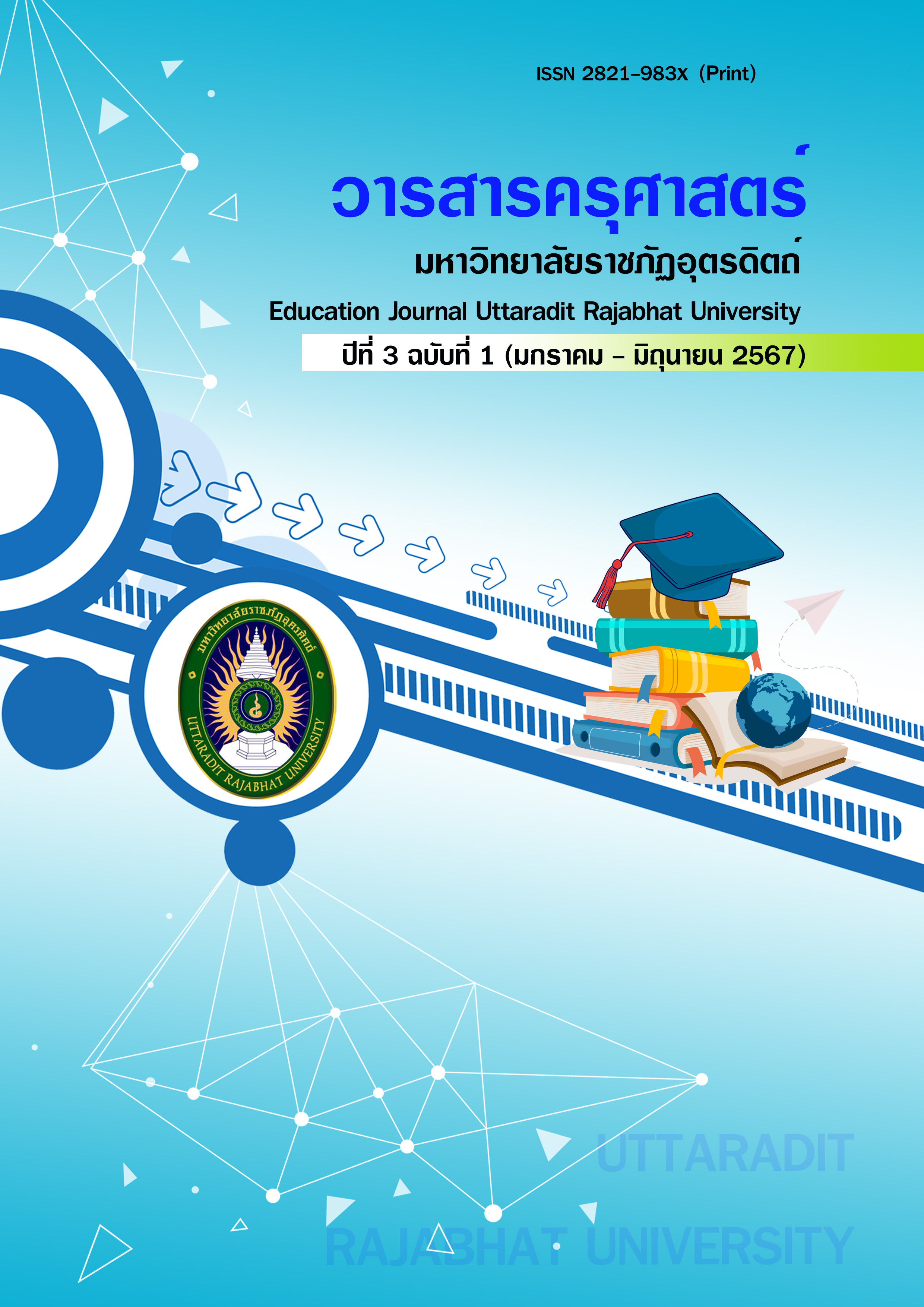การพัฒนาผลสัมฤทธิ์ทางการเรียนของนักเรียนชั้นประถมศึกษาปีที่ 6 เรื่อง วงจรไฟฟ้า ผ่านกิจกรรมการเรียนรู้แบบ MACRO model ร่วมกับกระบวนการทำงานเป็นกลุ่ม
Main Article Content
บทคัดย่อ
งานวิจัยในหัวข้อ "การพัฒนาผลสัมฤทธิ์ทางการเรียนของนักเรียนชั้นประถมศึกษาปีที่ 6 เรื่อง วงจรไฟฟ้า ผ่านกิจกรรมการเรียนรู้แบบ MACRO model ร่วมกับกระบวนการทำงานเป็นกลุ่ม"
มีวัตถุประสงค์เพื่อ ออกแบบกิจกรรมการเรียนรู้แบบ MACRO model ร่วมกับกระบวนการทำงานเป็นกลุ่ม เพื่อพัฒนาผลสัมฤทธิ์ของผู้เรียน เรื่อง วงจรไฟฟ้า และเพื่อพัฒนาทักษะการทำงานเป็นกลุ่ม ผ่านกิจกรรม
การเรียนรู้แบบ MACRO model รวมทั้ง เพื่อศึกษาระดับความพึงพอใจของนักเรียนชั้นประถมศึกษาปีที่ 6
ที่มีต่อกิจกรรมการเรียนรู้ กลุ่มเป้าหมายในการศึกษา คือนักเรียนชั้นประถมศึกษาปีที่ 6 ที่กำลังศึกษาอยู่ในภาคเรียนที่ 1 ปีการศึกษา 2566 โรงเรียนบ้านผาเวียง อำเภอศรีสัชนาลัย จังหวัดสุโขทัย จำนวน 23 คน
ใช้การคัดเลือกแบบเจาะจง เครื่องมือในการศึกษา ประกอบด้วย แผนการจัดการเรียนรู้แบบ MACRO model เรื่องวงจรไฟฟ้า จำนวน 2 แผน ระยะเวลารวม 3 ชั่วโมง และเครื่องมือสำหรับรวบรวมข้อมูล ประกอบด้วย แบบทดสอบก่อนเรียน แบบทดสอบหลังเรียน แบบสังเกตการทำงานกลุ่ม และแบบสอบถามความพึงพอใจ ผลการวิจัย พบว่า นักเรียนระดับชั้นประถมศึกษาปีที่ 6 มีคะแนนเฉลี่ยหลังเรียนสูงกว่าคะแนนนเฉลี่ยก่อนเรียนอย่างมีนัยสำคัญทางสถิติ ซึ่งมีคะแนนเท่ากับ 8.70 และ 5.22 ตามลำดับ ทักษะการทำงานเป็นกลุ่ม
ในภาพรวมของผู้เรียน มีค่าเฉลี่ยเท่ากับ 4.4 ซึ่งอยู่ในระดับดี ผู้เรียนมีความพึงพอใจต่อกิจกรรมการเรียน
การสอน ในภาพรวมอยู่ในระดับมาก โดยมีค่าเฉลี่ยรวมเท่ากับ 3.92
คำสำคัญ : การเรียนรู้แบบ MACRO model; กระบวนการทำงานเป็นกลุ่ม; ผลสัมฤทธิ์ทางการเรียน;วงจรไฟฟ้า
Article Details

อนุญาตภายใต้เงื่อนไข Creative Commons Attribution-NonCommercial-NoDerivatives 4.0 International License.
วารสารคณะครุศาสตร์ มหาวิทยาลัยราชภัฏอุตรดิตถ์ เป็นสื่อกลางในการเผยแพร่ผลงานวิจัย งานวิชาการความคิดเห็นใด ๆ ที่ปรากฏในบทความเป็นเพียงความคิดเห็นส่วนบุคคลของผู้เขียนเท่านั้นคณะครุศาสตร์ มหาวิทยาลัยราชภัฏอุตรดิตถ์ และกองบรรณาธิการไม่จำเป็นต้องมีความคิดเห็นที่สอดคล้องกับความคิดเห็นที่ปรากฎในบทความแต่อย่างใด และไม่ถือว่าเป็นความรับผิดชอบของคณะครุศาสตร์ มหาวิทยาลัยราชภัฏอุตรดิตถ์ และกองบรรณาธิการ
เอกสารอ้างอิง
กระทรวงศึกษาธิการ. (2551). หลักสูตรแกนกลางการศึกษาขั้นพื้นฐานพุทธศักราช 2551. กรุงเทพฯ : โรงพิมพ์ชุมชนสหกรณ์การเกษตรแห่งประเทศไทย จำกัด.
ดิเรก วรรณเศียร. (2559). เอกสารประกอบการสอน MACRO model : รูปแบบการจัดการเรียนรู้สำหรับศตวรรษที่ 21 มหาวิทยาลัยราชภัฏสวนดุสิต. สืบค้นจาก
http://regis.dusit.ac.th/images/news/1421308421_MACRO/
ธนพร เลิศโพธาวัฒนา. (2561). การพัฒนาความสามารถในการคิดวิเคราะห์และผลสัมฤทธิ์ทางการเรียนวิชาชีววิทยา เรื่อง ยีนและโครโมโซม โดยใช้รูปแบบการจัดการเรียนรู้สำหรับศตวรรษที่ 21: MACRO MODEL ของนักเรียนชั้นมัธยมศึกษาปีที่ 6. ปทุมธานี : มหาวิทยาลัยรังสิต.
นรรัชต์ ฝันเชียร.(2563). MACRO model โมเดลการสอนสู่ศตวรรษที่ 21(ออนไลน์). แหล่งที่มา: https://www.trueplookpanya.com/education/content/84985/-teamet-(สืบค้นเมื่อ 1 พฤษภาคม2567).
พวงรัตน์ ทวีรัตน์. (2530). การสร้างและพัฒนาแบบทดสอบวัดผลสัมฤทธิ์. กรุงเทพฯ : มหาวิทยาลัยศรีนครินทรวิโรฒ ประสานมิตร.
พงษ์ธลักษณ์ สิบแก้ว. (2562). เจตคติต่อการจัดการเรียนรู้แบบ MACRO เรื่อง ระบบประสาทของนักเรียนชั้นมัธยมศึกษาปีที่ 5. งานประชุมวิชาการระดับชาติ มหาวิทยาลัยรังสิต ประจ าปี 2562, 26 เมษายน 2562 (667-686). ปทุมธานี: มหาวิทยาลัยรังสิต.
พวงรัตน์ ทวีรัตน์. (2530). การสร้างและพัฒนาแบบทดสอบวัดผลสัมฤทธิ์. กรุงเทพฯ : สํานักทดสอบ
สถาบันส่งเสริมการสอนวิทยาศาสตร์และเทคโนโลยี (สสวท). (2563). หนังสือเรียนรายวิชาพื้นฐานวิทยาศาสตร์ เล่ม 1 ชั้นประถมศึกษาปีที่ 6 .กรุงเทพฯ: โรงพิมพ์สถาบันส่งเสริมการสอนวิทยาศาสตร์และเทคโนโลยี.
สุมาลี จันทร์ชลอ. (2542). การวัดและประเมินผล. กรุงเทพฯ: เพลท หจก.สุเมตรฟิล์ม.
สำนักงานคณะกรรมการการศึกษาขั้นพื้นฐาน. (2560). ตัวชี้วัดและสาระการเรียนรู้แกนกลางกลุ่มสาระการเรียนรู้วิทยาศาสตร์ (ฉบับปรับปรุง พ.ศ. 2560) ตามหลักสูตรแกนกลางการศึกษาขั้นพื้นฐานพุทธศักราช 2551. พิมพ์ครั้งที่ 1. กรุงเทพมหานคร : โรงพิมพ์ชุมนุมสหกรณ์การเกษตรแห่งประเทศไทย จำกัด.
สุภาพร มูฮำหมัด. (2564). ผลของการจัดการเรียนรู้แบบ MACRO model ที่มีต่อผลสัมฤทธิ์ ทางการเรียนของนักศึกษารายวิชาการออกแบบและจัดสภาพแวดล้อม สำหรับสถานศึกษาปฐมวัย. กรุงเทพฯ: คณะครุศาสตร์ มหาวิทยาลัยสวนดุสิต.
Casanova, M., & de Andrade, M. D. F. R. (2022). Group work as a learning strategy in higher education. Global Journal of Human-Social Science, 22(G5), 9-17.


